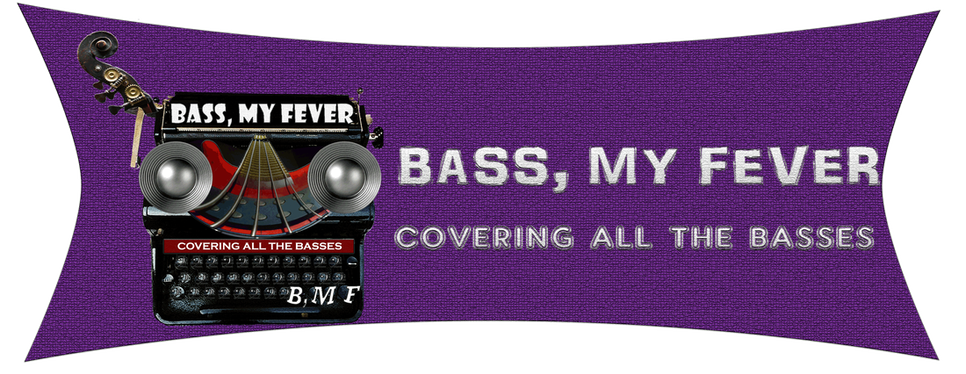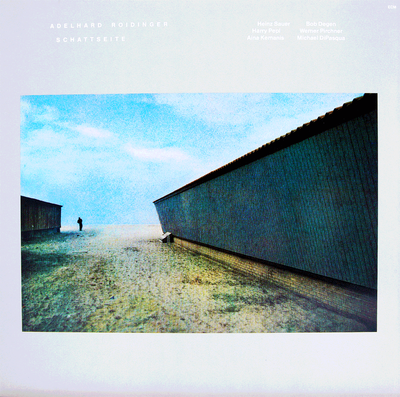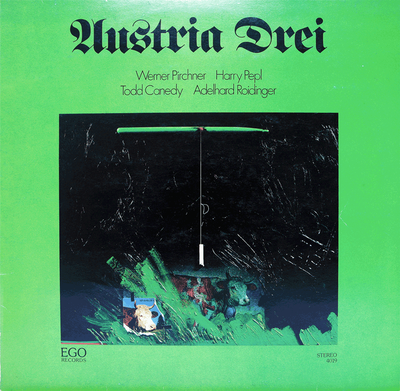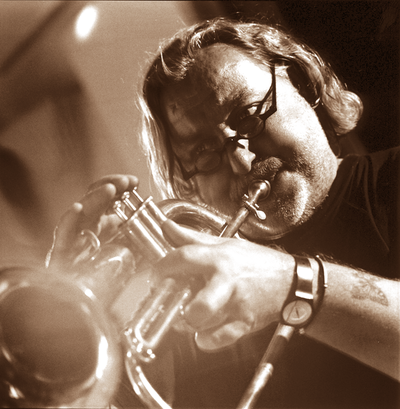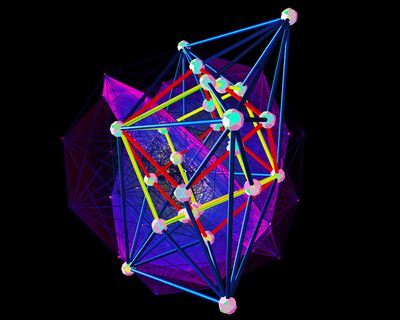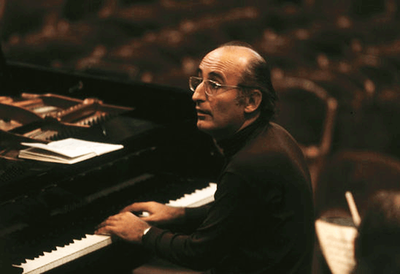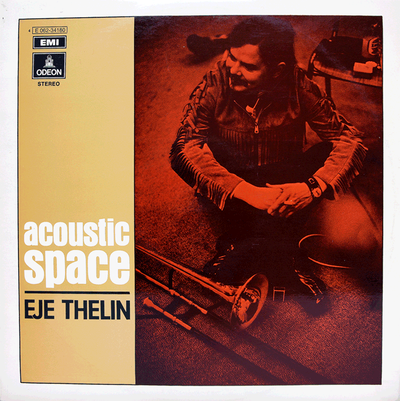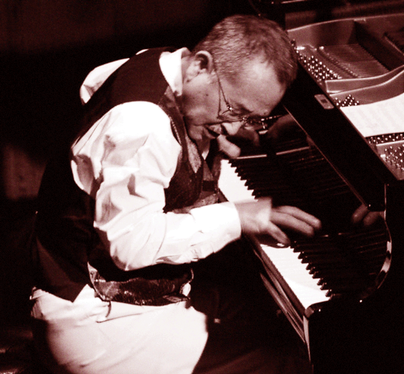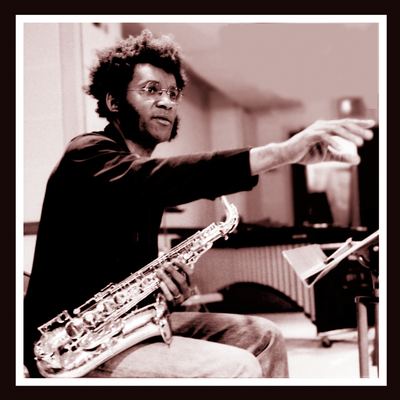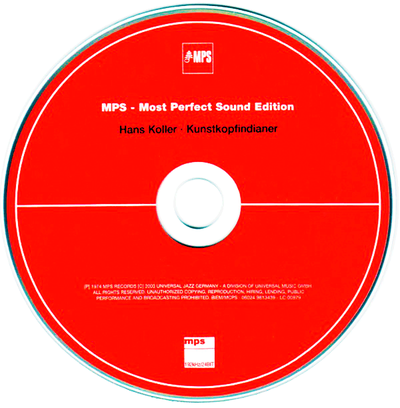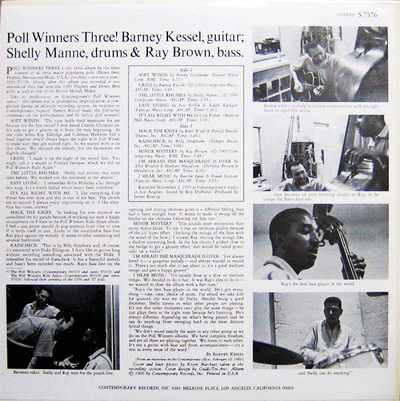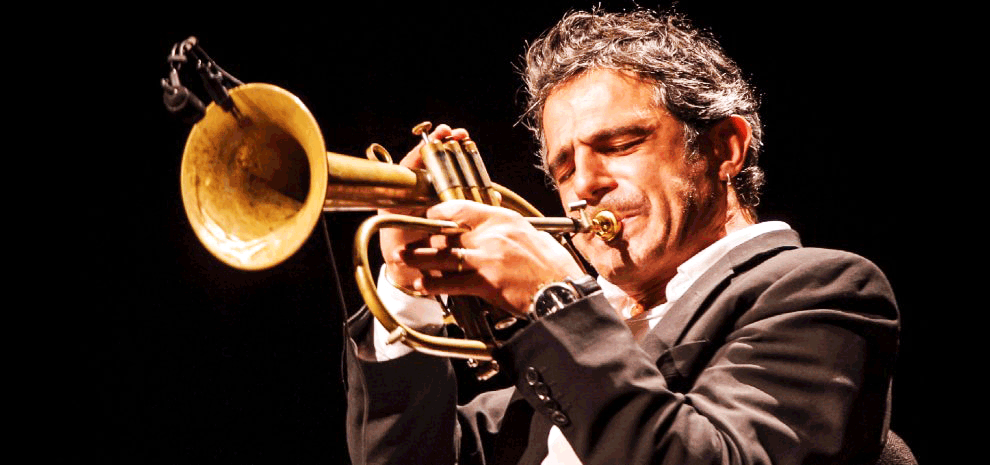INTERVIEW WITH ADELHARD ROIDINGER
|
«In 1978 I met Jaco Pastorius at the Jazz Festival in Berlin and we became close friends after he heard me rehearsing on stage. He jumped on stage and said: «Hey Adelhard, what you are playing? I never heard those lines in the USA before». Since this time he always called me, when he was touring with Weather Report in Europe». .................................. «Nel 1978 incontrai Jaco Pastorius al Jazz Festival di Berlino e diventammo grandi amici dopo che mi sentì provare sul palco. Saltò su e mi disse: «Hey Adelhard, che stai suonando? Non ho mai sentito queste linee di basso negli Stati Uniti». Da quella volta mi chiamò sempre quando si trovava in tour in Europa con i Weather Report» |
|
I can’t forget how I discovered Adelhard Roidinger and his music. I was a kid and I used to spend my whole days inside records stores; I was just at the beginning of my passion for electric&upright bass. In one of those stores where I liked to be most, I found this ECM vinyl with a beautiful cover and by reading on the back of it, I learnt that the leader, indeed Adelhard Roidinger, was a double bass player. I bought it immediately and it was an authentic stroke of luck, given that “Schattseite” is still today one of my favourite album, a record of rare beauty. |
Non posso dimenticare come “scoprii” Adelhard Roidinger e la sua musica. Ero adolescente e passavo le mie giornate nei negozi di dischi, ero agli inizi della mia passione per il basso elettrico e il contrabbasso. In uno dei negozi di dischi che frequentavo di più, trovai questo vinile della ECM con una splendida copertina e dal retro appresi che il leader, appunto Adelhard Roidinger, era un contrabbassista. Disco acquistato al volo e colpo di fortuna autentico, considerato che “Schattseite” è ancora oggi uno dei miei dischi dell’anima, di una bellezza rara. |
|
Later I deepened the huge career of Adelhard Roidinger as a double bass player and a composer, in addition to be also a really excellent electric bassist. We can mention two marvellous duo projects together with the fabulous pianist Yosuke Yamashita and the notable work called “Austria Drei” (on which there’s the guitarist Harry Pepl, who was already on “Schattseite”), the densest album “Lines” with Swiss saxophonist Urs Leimgruber and Swiss percussionist Fritz Hauser, in addition to a series of fantastic collaborations with valuable artists like Eje Thelin, Hans Koller, Herbert Joos, Karl Berger, the great Anthony Braxton, Tony Oxley, Albert Mangelsdorff, Daniel Humair, Wolfgang Dauner and thousands of others. |
Di Adelhard Roidinger ho in seguito scoperto la fulgida carriera come contrabbassista e compositore, eccellente anche sullo strumento elettrico. Due splendidi lavori in duo con il favoloso pianista Yosuke Yamashita, il notevole progetto Austria Drei (dove è presente il chitarrista Harry Pepl, già in “Schattseite”), il densissimo “Lines” con Urs Leimgruber e Fritz Hauser, oltre a una serie di collaborazioni felicissime con ragguardevoli musicisti del calibro di Eje Thelin, Hans Koller, Herbert Joos, Karl Berger, il grande Anthony Braxton, Tony Oxley, Albert Mangelsdorff, Daniel Humair, Wolfgang Dauner e mille altri. |
|
Surely we are faced with a great interpreter of double bass as well as a fine composer, who’s able to maintain his clear and recognisable signature style within the universal and multifaceted language of jazz. Adelhard Roidinger is a model role as regards the dynamics of the instrument and he’s a leading figure in a kind of jazz landscape that we could define as romantic and expressionist (“Schattseite” is a great example of this). But the languid refractions of the sound which are typical of ECM’s works are only a part of the background owned by this extraordinary musician, who seems to be comfortable with the most radical free, jazz improvisation and also with the duality jazz/electronica in addition to be a solid and precious accompanist. Adelhard Roidinger has written some excellent double bass and electric bass methods, he has been dealing with composition for computer, computer graphic design, studies about new geometry, and clearly about jazz, that is to say all high-livel disciplines. Which proves his own eclectic personality, as he’s able to best manage human as well as music resources which are characteristic aspects of the passion for transversality and multimedia. |
Di certo siamo di fronte a un grande interprete del contrabbasso e a un fine compositore, capace di mantenere un codice individuale nitido e riconoscibile nel linguaggio universale e multiforme del jazz. Adelhard Roidinger è un personaggio centrale nelle dinamiche del suo strumento ed è una figura di spicco in quella scena jazzistica che potremmo definire – e “Schattseite” ne è splendido esempio - “romantica” ed “espressionista”. Ma le languide rifrazioni sonore di casa ECM non sono che una parte del bagaglio di questo straordinario musicista, a suo agio nel free radicale, nell’improvvisazione come nelle contaminazioni jazz/elettronica e anche solido e prezioso accompagnatore. Adelhard Roidinger ha scritto degli eccellenti metodi tanto per contrabbasso che per basso elettrico, ha condotto studi d’informatica, di composizione elettronica, di nuova geometria e naturalmente di jazz, tutti di livello davvero rimarchevole. Questo a conferma di una personalità sfaccettata e capace di gestire al meglio le risorse dell’uomo e del musicista che vuole addentrarsi nella multidisciplinarietà e nella multimedialità. |
|
Indeed, this shows again that double bass (including electric bass, surely) is not just a means of music and sound expression because most of the time the best interpreter of this instrument are really curious people, so full of creativity and they also tend to cleverly fuse their own art inside wonderful armonic projects. We have interviewed Adelhard, and we thank him, but most of all we would like to strongly advise young people or student who approach to jazz to discover and explore his anything but obvious music, so full of discipline, inventiveness, devotion to art and courage. |
E ancora, questa è l’ennesima riprova che il contrabbasso (ma anche il basso elettrico, a ben vedere) è strumento che porta con sé non solo la musica e il suono, perché quasi sempre i suoi migliori interpreti sono uomini pieni di curiosità, intraprendenza artistica e smaccata propensione nel mescolare sapidamente le arti in progetti armonici di grande bellezza. Abbiamo intervistato Adelhard, che ringraziamo, e ci sentiamo di raccomandare caldamente ai giovani che si avvicinano al jazz e all’improvvisazione di conoscere ed esplorare la sua musica mai banale, pregna di rigore, inventiva, devozione all’arte e coraggio. |
LIKE a SOUND SCULPTURE shaped by THE BASS LINES |
COME UNA SCULTURA SONORA PLASMATA DALLE LINEE DI BASSO |
|
BMF: Adelhard, would you like to talk about the beginning of your musical path, your first approach to double bass as well as the first steps in your bright musical career? ADELHARD ROIDINGER: At the age of five years I took piano lessons, later violin and guitar. When I was fifteen years old, the genius jazz bass player Ray Brown inspired me to learn double bass. I looked for a classical double bass teacher and luckily I took lessons from the Solo double bass player from the Opera Orchestra Linz / Austria. During this time I had to keep my interest in jazz playing secret. When I was eighteen years old, I moved to Graz, starting my study in Architecture and Fine Arts and classical double bass. At this time, Graz was the Austrian centre of Jazz. Soon I met some of the leading musicians of the scene, for example Harald Neuwirth, one of the co - founder of the Jazz Department in Graz, the first in Europe. I played guitar and double bass in his trio, more and more a lot of musicians wanted me on bass, also because almost nobody at this time was able to read notes. One year later the Harald Neuwirth Trio won a price at the Amateur Jazz Festival in Vienna – a festival invented by the pianist Friedrich Gulda, a famous classical and jazz player at this time - and I got a solo prize for my bass playing. The next year we won as a trio the first price. After finishing my study at the University of Technology I decided to become a professional Jazz player. |
BMF: Adelhard, puoi raccontare ai nostri lettori i tuoi inizi, i tuoi primi approcci al contrabbasso e i primi passi della tua luminosa carriera? ADELHARD ROIDINGER: Ho iniziato a prendere lezioni di piano all’età di cinque anni, in seguito ho approcciato il violino e la chitarra. Quando ne avevo quindici il bassista geniale Ray Brown mi fece avvicinare allo studio del contrabbasso. Mi misi alla ricerca di un insegnante di stampo classico e per fortuna presi lezioni dal contrabbassista solista dell’Opera Orchestra Linz in Austria. Durante quel periodo fui costretto a mantenere segreto il mio interesse per il jazz. Una volta diventato maggiorenne mi trasferii a Graz, per iniziare i miei studi di Architettura e Belle Arti e Contrabbasso classico. A quel tempo Graz rappresentava il polo austriaco del Jazz. Feci presto conoscenza con i musicisti protagonisti della scena di allora come ad esempio Harald Neuwirth uno dei co-fondatori del Dipartimento del Jazz di Graz, il primo in Europa. Iniziai a suonare la chitarra ed il contrabbasso nel suo trio, sempre più musicisti volevano che suonassi il basso, anche perché quasi nessuno in quel periodo era in grado di leggere le note. Un anno più tardi l’ Harald Neuwirth Trio vinse un premio all’ Amateur Jazz Festival di Vienna – una rassegna creata dal pianista Friedrich Gulda, un famoso musicista di musica classica e jazz in quel momento – e mi aggiudicai un premio come solista per il mio modo di suonare il basso. L’anno successivo vincemmo il primo premio come trio. Dopo aver terminato gli studi all’Università di Tecnologia decisi di diventare un jazzista professionista. |
|
At this time, the great trombone player from Sweden, Eje Thelin was teaching in Graz at the Jazz department. We became friends and very soon I was his favourite bass player. Together with Joachim Kühn (piano) we recorded in 1970 in Stockholm the Lp “Acoustic space” and later in Paris the double-Lp “The New Eje Thelin & Joachim Kühn Quartet in Paris”. 1970 was also the year when I performed the first time in Germany, which was my successful step into the European Jazz scene. After that I became a very busy bass player in Europe and played also with famous American Jazz artists. |
All’epoca il grande trombonista svedese Eje Thelin insegnava al Dipartimento di Jazz di Graz. Diventammo amici e molto presto divenni il suo bassista preferito. Insieme a Joachim Kühn (piano) incidemmo nel 1970 a Stoccolma l’Lp “Acoustic Space” e in seguito a Parigi il doppio Lp “The New Eje Thelin & Joachim Kühn Quartet in Paris”. Il 1970 fu anche l’anno in cui mi esibii per la prima volta in Germania, il che costituì il mio balzo decisivo nella scena del Jazz Europeo. Dopo di che fui molto impegnato in Europa e iniziai a suonare con noti artisti jazz americani. |
|
BMF: You have collaborated with great artists like Anthony Braxton and Yosuke Yamashita, what do you remember about those experiences? I met Yosuke in 1975 at the Jazz Festival in Berlin. He performed with his Trio and I performed with a very successful band together with Hans Koller ts + ss, Wolfgang Dauner (on piano), Zbiginiew Seifert (on violin), Janusz Stefanski (on drums) and myself on double bass and electric bass. Yosuke´s trio performed without a bass player and immediately we decided to record together. On the Japanese label FRASCO we recorded in 1967 “A Day In Munich”, in 1977 on ENJA “Inner Space” which became very successful in Japan and in 1977 in Japan “Wave Song”. I also recorded with his extraordinary alto and clarinet player Akira Sakata the Lp “Counter Clockwise Trip”. In 1977 Yosuke invited me to Japan and we played as a Duo a three week tour including a famous all night festival in Tokyo and a recording. Years later I invited him for a tour through Europe. We always felt as “brothers from another mother” and talked a lot about Japanese Philosophy and Architecture. During my study in Architecture one of my great interests was Japanese Architecture especially the design of Japanese Tea Houses. Yosuke is also a very successful writer in Japan and in one of his books he wrote more than thirty pages about me and our collaborations. |
BMF: Hai lavorato con grandi artisti come Anthony Braxton e Yosuke Yamashita, che ricordi hai di quelle esperienze? AR: Incontrai Yosuke nel 1975 al Jazz Festival di Berlino. Si esibì con il suo Trio ed io suonai insieme ad una band di grande successo formata da Hans Koller ts + ss, Wolfgang Dauner (piano), Zbiginiew Seifert (violino) Janusz Stefanski (batteria) e il sottoscritto al contrabbasso e basso elettrico. Il trio di Yosuke si esibiva senza un bassista così decidemmo subito di incidere insieme. Registrammo per l’etichetta giapponese FRASCO nel 1967 “A Day In Munich”, nel 1977 per l’ENJA “Inner Space” che divenne molto famoso in Giappone e nel 1977 sempre in Giappone “Wave Song”. Ho inoltre inciso nel 1967 con Akira Sakata al sax alto e clarinetto l’Lp “Counter Clockwise Trip”. Nel 1977 Yosuke mi invitò in Giappone e suonammo come Duo in un tour di tre settimane che includeva un noto all night festival in Tokyo ed una incisione. Anni più tardi lo invitai per un tour in giro per l’Europa. Ci siamo sempre sentiti come “fratelli di madri diverse” e parlavamo molto di Filosofia Giapponese e di Architettura. Nutrivo un grande interesse per quella Giapponese specie per il design degli Chashitsu. Yosuke è inoltre uno scrittore molto famoso in Giappone e in uno dei suoi libri ha scritto più di trenta pagine su di me e sulle nostre collaborazioni. |
|
I have known Anthony Braxton for a long time and it was always my wish to play with him. In 1989 the Swiss Label HAT HUT owner, Werner X. Uehlinger, organized a tour through Europe with Anthony Braxton, Tony Oxley on drums and myself on double bass. Anthony and I became deep friends during the tour. We also recorded a Cd in Amiens, France. |
Conosco Anthony Braxton da molto tempo ed è sempre stato un mio desiderio suonare con lui. Nel 1989 il proprietario dell’etichetta svizzera HAT HUT, Werner X. Uehlinger, organizzò un tour per l’Europa con Anthony Braxton, Tony Oxley alla batteria e il sottoscritto al contrabbasso. Anthony ed io diventammo molto amici durante il tour. Registrammo anche un disco ad Amiens, in Francia. |
|
|
|
|
BMF: You have also played electric bass to great effect I think for instance about a song like “Khartres”. How is your relationship with the electric instrument? AR: I loved electric bass since I was fourteen years old. During my study in Graz I also played electric bass in a successful pop band and when I was on tour I always carried my electric bass with me. I created a double necked instrument with an electric bass and an electric guitar on the same body. In 1978 I met Jaco Pastorius at the Jazz Festival in Berlin and we became close friends after he heard me rehearsing on stage. He jumped on stage and said: «Hey Adelhard, what are you playing? I never heard those lines in the USA before». Since this time he always called me, when he was touring with Weather Report in Europe. |
BMF: Hai suonato anche il basso elettrico con risultati notevoli, penso ad esempio ad un pezzo come “Khartres”. Com’è il tuo rapporto con lo strumento elettrico? AR: Amo il basso elettrico da quando avevo 14 anni. Durante i miei studi a Graz l’ho persino suonato in una nota pop band e quando ero in tour portavo sempre con me un basso elettrico e una chitarra. Creai persino uno strumento a doppio manico con un basso elettrico ed una chitarra elettrica sullo stesso corpo. Nel 1978 incontrai Jaco Pastorius al Jazz Festival di Berlino e diventammo grandi amici dopo che mi sentì provare sul palco. Saltò su e mi disse: «Hey Adelhard, che stai suonando? Non ho mai sentito queste linee di basso negli Stati Uniti». Da quella volta mi chiamò sempre quando si trovava in tour in Europa con i Weather Report. |
|
|
|
|
BMF: In 1982 your album “Schattseite” was published under your name by ECM Records, I’ve always found it beautiful, a real gem inside the German label’s infinite production. This fantastic album was available only in vinyl format. How was the development of the compositional process? Are there any possibilities to find it reissued in cd format sooner or later? AR: I met Manfred Eicher in 1970 for the first time in Munich. I was at this time the “house” bass player of the famous Jazz Club in Munich and played for a whole week with Mal Waldron on piano. Mal recorded with John Coltrane. We walked down the Singer Street where the club was located and he told me that he would have given up his bass playing and would have started a record label called ECM. He asked me, who should have been the first musician to record with. I said: record with Mal Waldron and he did so. In 1977 we met again in Berlin and he told me that he wanted to do a recording with me, after hearing the Record “Kunstkopfindianer” of 1974 with Hans Koller and Wolfgang Dauner. I still hope that “Schattseite” will be reissued as a Cd in the future. |
BMF: Nel 1982 per la ECM uscì un album a tuo nome, “Schattseite”, che ho sempre trovato bellissimo, una vera perla nella sconfinata produzione dell’etichetta tedesca. Questo fantastico album è uscito solo in vinile. Come è stata la gestazione del processo compositivo di “Schattseite”? E ci sono prospettive di vederlo ristampato in cd prima o poi? AR: Ho incontrato Manfred Eicher nel 1970 per la prima volta a Monaco. Ero in quel periodo il bassista ufficiale del noto jazz club della città e suonai per un’intera settimana con Mal Waldron al piano. Mal incise con John Coltrane. Camminammo per Singer Street dove era ubicato il Club e lui mi disse che avrebbe smesso di suonare il suo basso per fondare un’etichetta di nome ECM. Mi chiese con quale musicista avrebbe dovuto incidere per primo. Ed io risposi: registra con Mal Waldron e così fece. Nel 1977 ci incontrammo di nuovo a Berlino e mi disse di voler fare un disco con me, dopo aver ascoltato l’album “Kunstkopfindianer” del 1974 con Hans Koller e Wolfgang Dauner. Ancora spero che “Schattseite” venga ristampato come Cd in futuro. |
|
BMF: What about your main influences, and more specifically, about double bass and electric bass? AR: My hero, when I was sixteen, was the master of double bass, Ray Brown, especially the recordings with Barney Kessel on guitar have been fascinating for me. He is still the greatest and honest bass player for me. I also have to mention Oscar Pettiford and his ability of improvising in the language of a horn player. In the age of eighteen I heard the first time Wes Montgomery. His playing was unbelievable and he is still an infinite source in my musical life. I do love the electric bass playing from Jaimy Jamerson, the incredible Motown style creator and all the funky players, including Stanley Clarke, Marcus Miller, Jaco Pastorius of course. |
BMF: Quali sono state le tue principali influenze in genere e più specificamente per contrabbasso e basso elettrico? AR: Il mio modello di quando avevo sedici anni, fu il Maestro del contrabbasso Ray Brown, specie le incisioni con Barney Kessel alla chitarra mi affascinavano. È ancora il bassista più grande e autentico per me. Devo anche citare Oscar Pettiford e la sua abilità improvvisativa attraverso il linguaggio del trombettista. All’età di 18 anni sentii per la prima volta Wes Montgomery. Il suo modo di suonare era incredibile e rappresenta tutt’ora un’inesauribile fonte di ispirazione nel mio percorso musicale. Adoro il sound elettrico di Jaimy Jamerson, l’incredibile creatore dello stile Motown e tutti i musicisti funky, incluso Stanley Clarke, Marcus Miller, Jaco Pastorius ovviamente. |
|
BMF: You wrote two guides referred to electric bass and upright bass in jazz music. How is your relationship to teaching? AR: Joe Viera, a fine soprano player from Munich and one of the first serious Jazz teachers in Europe invited me to write a book about double bass and electric bass in Jazz for the UNIVERSAL EDITION. They became popular in the jazz scene. Later, in 1987 I wrote a book about Jazz Improvisation & Pentatonic, published by “Advance Music”, Veronika Gruber, Rottenburg Germany. It also became successful in the USA. The last fifteen years the book was out of print. Kurt Rosenwinkel, one of the best Jazz Guitar players in our time recommended it in 2015 on a US Jazz magazine, and this made it possible for me, to bring it out again, since 2016 has been available on Edition Schott in Germany. |
BMF: Hai scritto due manuali riferiti a basso elettrico e contrabbasso nel jazz. Qual è il tuo rapporto con l’insegnamento? AR: Joe Viera, un elegante sax soprano di Monaco ed uno dei primi insegnanti di jazz seri in Europa, mi propose di scrivere un libro sul basso elettrico ed il contrabbasso Jazz per la UNIVERSAL EDITION. Era noto nel panorama jazz. Più tardi, nel 1987 scrissi un libro sull’improvvisazione e la scala pentatonica pubblicato da “Advance Music”, Veronika Gruber, Rottenburg Germany. Negli ultimi quindici anni il libro è andato fuori catalogo. Kurt Rosenwinkel uno dei migliori chitarristi jazz dei giorni nostri lo raccomandò ad una rivista jazz nel 2015, e questo mi ha consentito di riportarlo alla luce e dal 2016 è disponibile nella Schott Edition tedesca. |
|
BMF: In your career you have ranged from classic jazz to free improvisation and you have been one of the people who pioneered the union between jazz and electronic music. Do these different approaches and contexts also reflect your identity of listener? AR: Every artist has his own way to survive. In my case, I always wanted to learn as many different aspects of ART as possible, for example musical instruments (piano, violin, guitar, double bass, electric bass, trumpet), painting, sculpturing, the geometry of plants by taking photographs (starting in the age of 13), Architecture, Design studies in London, Computer Music studies in Paris (IRCAM, Atelier UPIC). The more you know about music as a bass player, the more you lose the joy of playing bass lines. The better you play, the less musicians want to play with you. It´s bizarre, but true. That’s the reason, why a lot of fine bass players become all kind of depressions. Ray Brown for example didn´t play for eighteen years. The same thing happened to me. A bass player carrier is completely different to a piano or guitar player carrier. To survive psychological, I started teaching, building up a Jazz Department in Linz / Austria and composed a lot of computer compositions and computer graphics in my own studio. At the internationally well-known ARS ELECTRONICA in Linz, I received Honorable Mentions in both categories. |
BMF: Nella tua carriera hai spaziato dal jazz classico alla libera improvvisazione e sei stato uno dei pionieri nel connubio jazz/elettronica. Questa varietà di approcci e situazioni rispecchia anche la tua dimensione di ascoltatore? AR: Ogni artista ha il proprio modo di tirare avanti. Nel mio caso ho sempre voluto apprendere quanti più differenti aspetti dell’Arte possibili, come ad esempio gli strumenti musicali (piano, violino, chitarra, contrabbasso, basso elettrico, tromba), la pittura, la scultura, la geometria delle piante attraverso le fotografie (ho iniziato a 13 anni), l’Architettura, gli studi di Design a Londra, gli studi della musica per Computer a Parigi (IRCAM, Atelier UPIC). Più conosci la musica in qualità di bassista, più ti privi del piacere di suonare le linee di basso. Quanto più sei valido come musicista, sempre meno musicisti vogliono suonare con te. È bizzarro, ma è vero. Ed è questo il motivo per cui un mucchio di bravi bassisti cadono in ogni tipo di depressione. Ray Brown per esempio non ha suonato più per diciotto anni. La stessa cosa è successa a me. La carriera di un bassista è completamente diversa da quella di un pianista o di un chitarrista. Per sopravvivere psicologicamente ho iniziato ad insegnare mettendo su un dipartimento di Jazz a Linz in Austria e ho scritto molte composizioni digitali e grafiche per computer nel mio studio. Presso l’ARS ELECTRONICA rinomata a livello internazionale a Linz ho ricevuto menzioni d’onore in entrambe le categorie. |
|
BMF: What are your plans for the immediate future and the days to come? AR: After ten years being mainly a composer I decided to learn my youth instrument, the guitar. I started with all kinds of seven and eight string electric basses and for three years I've been playing a 7 string electric guitar with longer scale and deeper tuning. I call it a seven string tenor electric bass. Next month I will start recording in a more experimental set up as a duo with piano in Cologne and in 2018 I plan to record a lot of my own compositions, which I composed the last years especially for my new instrument. |
BMF: Quali sono i tuoi progetti per l’immediato e prossimo futuro? AR: Dopo dieci anni tracorsi principalmente componendo, ho deciso di imparare il mio strumento della giovinezza, la chitarra. Ho approcciato tutti i tipi di bassi elettrici a sette e otto corde, da tre anni suono una chitarra elettrica a sette corde con una scala più lunga e accordi più profondi. Io la chiamo basso elettrico tenore a sette corde. Il prossimo mese inizierò a registrare una creazione più sperimentale come duo con un piano a Colonia e nel 2018 ho previsto di incidere molti dei miei lavori che ho composto gli scorsi anni specie per i miei nuovi strumenti. |
